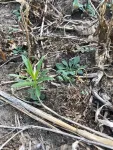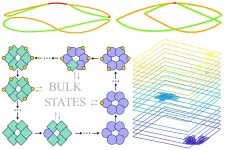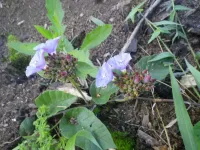Reverse optogenetic tool developed
2021-07-23
(Press-News.org) A new optogenetic tool, a protein that can be controlled by light, has been characterized by researchers at Ruhr-Universität Bochum (RUB). They used an opsin - a protein that occurs in the brain and eyes - from zebrafish and introduced it into the brain of mice. Unlike other optogenetic tools, this opsin is not switched on but rather switched off by light. Experiments also showed that the tool could be suitable for investigating changes in the brain that are responsible for the development of epilepsy.
The teams led by Professor Melanie Mark from the Behavioural Neurobiology Research Group and Professor Stefan Herlitze from the Department of General Zoology and Neurobiology describe the experiments and results in the journal Nature Communications, published online on 23 July 2021.
Role assumed in various conditions
The opsin Opn7b is a G protein-coupled receptor which is found in zebrafish. Unlike many other light-activated G protein-coupled receptors, it can be activated without a light stimulus and is thus permanently active; researchers call this constitutively active. Normally, activation of G protein-coupled receptors leads to an opening of certain ion channels and thus to the influx of ions into the cell as well as to further signalling processes in the cell. In the case of Opn7b, light deactivates this permanently active signalling chain.
Little research has so far been conducted on G protein-coupled receptors that are activated without stimulation, although it is presumed that they play a role in various neuropsychiatric conditions and night blindness. They also appear to be involved in the development of virally induced cancers.
Receptor characterized more precisely
Dr. Raziye Karapinar, Dr. Ida Siveke and Dr. Dennis Eickelbeck characterized the function of Opn7b in detail and, to their surprise, identified that the receptor is deactivated by light. In contrast, conventional optogenetic tools are switched on by light.
The researchers consider Opn7b well-suited to gain further insights into the function of G protein-coupled receptors that are constitutively active - and obtain new knowledge of their role in the development of diseases in which the receptors can be examined in a time-controlled manner in specific cell types.
Epileptic seizures
The Bochum researchers Dr. Jan Claudius Schwitalla and Johanna Pakusch changed certain cells in the cerebral cortex of mice in such a way that they produced Opn7b. If they deactivated the receptor with light, it triggered epileptiform activity in the animals, which could be specifically controlled with light and interrupted with the help of other light-controlled proteins. The researchers hope that it will be possible to use this optogenetic tool to understand more precisely both the underlying mechanisms and the timescales in the development of epileptic seizures.
INFORMATION:
ELSE PRESS RELEASES FROM THIS DATE:
2021-07-23
As the SARS-CoV-2 virus that causes COVID-19 continues to evolve, immunologists and infectious diseases experts are eager to know whether new variants are resistant to the human antibodies that recognized initial versions of the virus. Vaccines against COVID-19, which were developed based on the chemistry and genetic code of this initial virus, may confer less protection if the antibodies they help people produce do not fend off new viral strains. Now, researchers from Brigham and Women's Hospital and collaborators have created an "atlas" that charts how 152 different antibodies attack a major ...
2021-07-23
Many species within Kenya's Tana River Basin will be unable to survive if global temperatures continue to rise as they are on track to do - according to new research from the University of East Anglia.
A new study published in the journal PLOS ONE today outlines how remaining within the goals of the Paris Agreement would save many species.
The research also identifies places that could be restored to better protect biodiversity and contribute towards global ecosystem restoration targets.
Researcher Rhosanna Jenkins carried out the study as part of her PhD at UEA's School of Environmental Sciences.
She said: "This research shows how many species within Kenya's Tana River Basin will be unable to survive if global temperatures continue to rise as they are on track to do.
"But remaining ...
2021-07-23
For young soccer players, participating in repetitive technical training activities involving heading during practice may result in more total head impacts but playing in scrimmages or actual soccer games may result in greater magnitude head impacts. That's according to a small, preliminary study released today that will be presented at the American Academy of Neurology's Sports Concussion Conference, July 30-31, 2021.
"Headers are a fundamental component to the sport of soccer. Therefore, it is important to understand differences in header frequency and magnitude across practice and game settings," said study author Jillian Urban, PhD, MPH, of Wake ...
2021-07-23
University of Virginia School of Medicine researchers have discovered a previously unknown repair process in the brain that they hope could be harnessed and enhanced to treat seizure-related brain injuries.
Common seizure-preventing drugs do not work for approximately a third of epilepsy patients, so new and better treatments for such brain injuries are much needed. UVA's discovery identifies a potential avenue, one inspired by the brain's natural immune response.
Using high-powered imaging, the researchers were able to see, for the first time, that immune cells called microglia were not just removing damaged material after experimental seizures but actually appeared to be healing damaged neurons.
"There has been mounting generic support for the idea that microglia ...
2021-07-23
WESTMINSTER, Colorado - July 23, 2021 - Horseweed is a serious threat to both agricultural crops and natural landscapes around the globe. In the U.S., the weed is prolific and able to emerge at any time of the year.
Fall emerging horseweed overwinters as a rosette, while spring emerging horseweed skips the rosette stage and grows upright. In some instances, both rosette and upright plants emerge simultaneously in mid-summer. These unpredictable growth patterns create challenges for growers as they try to develop an appropriate weed management plan.
In a study featured in the journal Weed Science, a team from Michigan State University explored whether environmental cues could be used to predict horseweed growth ...
2021-07-23
A research team led by Dr Rosario Delgado from the UAB Department of Mathematics, in collaboration with the Hospital de Mataró, developed a new machine learning-based model that predicts the risk of mortality of intensive care unit patients according to their characteristics. The research was published in the latest edition of the journal Artificial Intelligence in Medicine, with a special mention as a "Position paper".
Under the framework of Artificial Intelligence, machine learning allows a model to gain knowledge based on the information provided by available ...
2021-07-23
When can we say that a certain property of a system is robust? Intuitively, robustness implies that, even under the effect of external perturbations on the system, no matter how strong or random, said property remains unchanged. In mathematics, properties of an object that are robust against deformations are called topological. For example, the letters s, S, and L can be transformed into each other by stretching or bending their shape. The same holds true for letters o, O, and D. However, it is impossible to turn an S into an O without a discontinuous operation, such as cutting the O apart or sticking the two ends of the S together. Therefore, we say that the letters s, S and L have the same topology - as do the letters o, O and D - ...
2021-07-23
Chemotherapy has helped make acute lymphoblastic leukemia (ALL) one of the most survivable childhood cancers. Now, researchers working in the U.S., Germany and China have shown how chemotherapy drugs called thiopurines can lead to mutations that set patients up for relapse. The work appears today in the journal Nature Cancer.
The research provides the first direct genomic and experimental evidence in pediatric cancer that drug-resistant mutations can be induced by chemotherapy and are not always present at diagnosis.
"The findings offer a paradigm shift in understanding how drug resistance develops," said Jinghui Zhang, Ph.D., Department of Computational Biology chair at St. Jude Children's Research Hospital. "The ...
2021-07-23
Rivers are lifelines for many countries. They create valuable ecosystems, provide drinking water for people and raw water for agriculture and industry. In the Global South in particular, there is strong competition for access to freshwater resources. The increasing use of hydropower has recently intensified this competition further.
Take Ethiopia, for example: when the country began filling the mega-?dam Gibe III on the Omo River in 2015, downstream users saw a drop in water volumes. Natural flooding declined, reducing the volume of fertile mud washed onto the floodplain. The level of Kenya's Lake Turkana, into which the Omo flows, fell temporarily by two metres, resulting in significant consequences for people and agriculture.
Addressing ...
2021-07-23
Scientists have identified five new plant species in the Bolivian Andes.
The species are all part of the genus Jacquemontia, which are twining or trailing plants with pretty blue flowers.
With rapid biodiversity loss taking place across South America and worldwide, identifying plant species is a vital step towards protecting them.
The new study, which classifies and describes the 28 Jacquemontia species now known to live in Bolivia and Peru, was carried out by the universities of Exeter and Oxford, and the Royal Botanic Gardens, Kew.
"Many plant species have not been identified and classified, especially in the tropics," said Rosie Clegg, of the University of Exeter and Kew.
"If you don't know what a species is, you can't ...
LAST 30 PRESS RELEASES:
[Press-News.org] Reverse optogenetic tool developed





